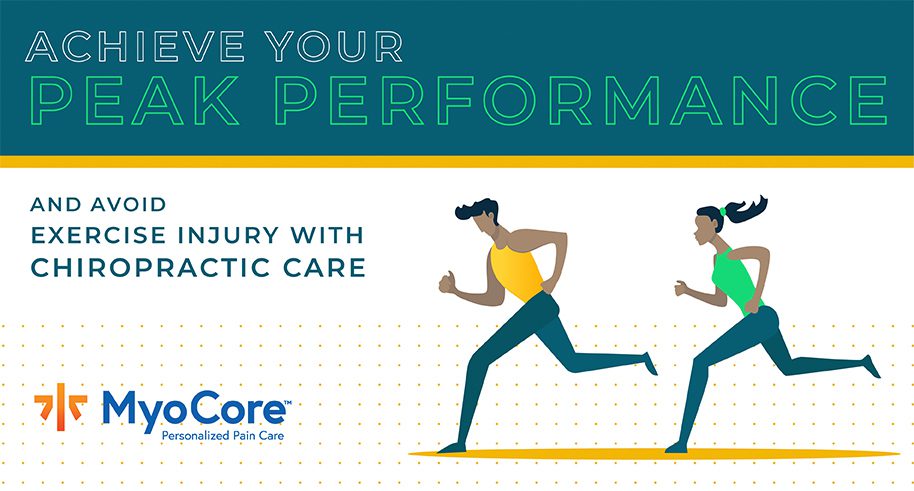
Achieve Your Peak Performance – The Infographic
June 6, 2021
By MyoCore
Download this simple guide to learn about some of the most common exercise injuries facing athletes today… and what you can do to prevent them!
Injured? It’s time to grab the heating pad… or the ice pack… or both—who even knows! There’s a lot of confusion when it comes to using heat or ice to help treat common injuries like strains, sprains, pulled muscles, shin splits, knee injuries and tenderness.
When it comes to choosing between ice or heat therapy, recent research supports using whichever one feels best to you! But if you’re not sure, follow this temperature guide on Heat & Ice therapy below so you can recover and heal faster!
Cold Therapy
As a general rule, always choose ice for injuries and inflammation. Cold restricts blood flow and reduces inflammation and swelling. Whenever there’s bleeding in underlying tissue—think sprains, strains or bruising—ice treatment is the way to go. You can use cold therapy in two ways: immediate or rehabilitation.
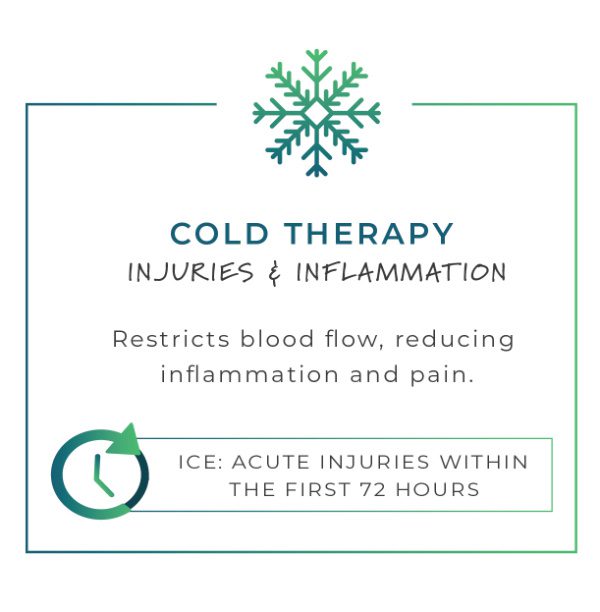
Immediate Treatment: helps prevent the injured area from becoming stiff by reducing tissue fluid.
Rehabilitation: aims to restore normal function to an affected area by reducing pain and spasms, which in turn allows for better movement.
Conditions for Ice Therapy
- Recent Injuries
- Swelling
- Strains & Sprains
- Joint Pain

If you have bad circulation, then cold therapy probably isn’t for you. If you apply ice for too long (or directly!) then skin, tissue or nerve damage becomes a possibility. If you have cardiovascular disease always consult with their doctor before using cold therapy.
Heat Therapy
Usually, heat is the best temperature therapy for relaxing—whereas ice restricts blood vessels, heat opens them, increasing blood flow to an affected area. This is perfect for most aches and pains, and it is also great for repairing damaged tissue since increased blood flow stimulates healing. Minor stiffness and tension can usually be relieved with about 15-20 minutes of heat therapy.

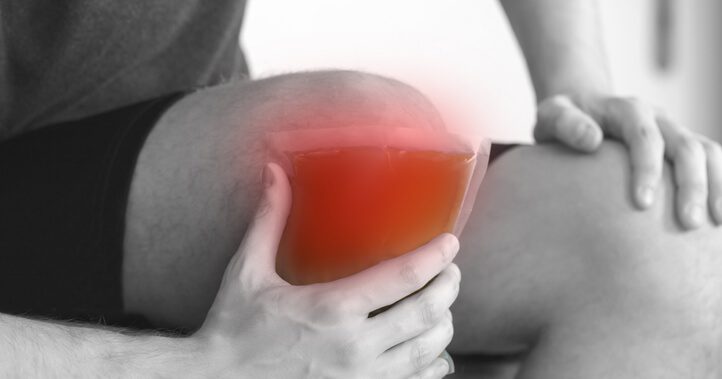
Do not feel the burn! When using heat therapy, you want to keep a nice, even warmth. If you have swelling or bruising, heat isn’t the right call. Never use it near open wounds, and for people with heart disease or hypertension, always ask your doctor before using this treatment.
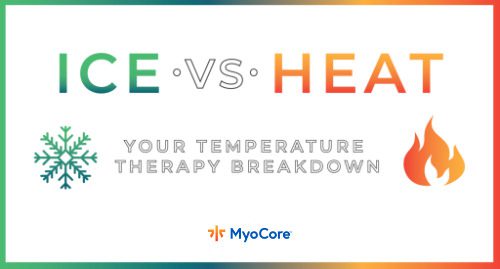
The Complete Heat & Ice Guide
The Ultimate Treatment
When it comes to injuries caused by physical activity, heat or ice therapy can be beneficial, but they are not long-term solutions.
A healthy musculoskeletal system is critical to overall health and healing, affecting how the entire body functions. Chiropractic care can reduce tension and pain and to speed up your recovery time, if an injury happens.
What you need to know about ice and heat therapy for injury care, sore muscles. inflammation and more!
Chiropractic isn’t just for your back! As experts in the musculoskeletal system, our offices specialize in treating extremity conditions to relieve pain and discomfort by improving joint motion, optimizing muscle function, and restoring proper flexibility and strength.
30 Million doctor visits a year are due to knee and shoulder injuries alone.
Common Extremity Issues
- Sciatica
- Arthritis
- Plantar Fasciitis
- Carpal Tunnel Syndrome
- Bursitis
- Tendonitis
- Runner’s Knee
- Bone Spurs
- Muscle Strain
- Shin Splints
- ACL/MCL Injury
- Tennis Elbow
- Torn Rotator Cuff
- Numbing/Tingling
- TMJD
While chiropractors are commonly known to treat spinal issues, we can also help with extremity conditions by using muscle therapy, exercise, and joint adjustments.
Extremity Adjustments
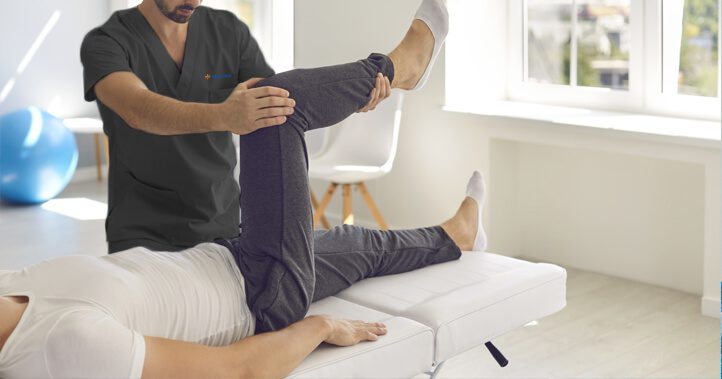
Can restore joint motion to a restricted joint and reduce pain, allowing for proper joint function.
Muscle Therapy
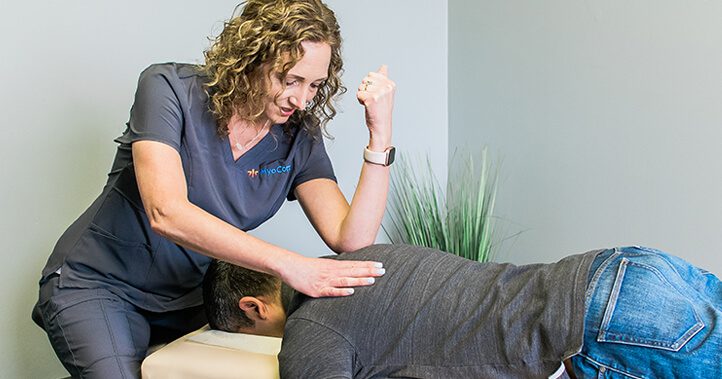
And rehab exercises help to strengthen the muscles around the joint, which can help decrease inflammation and swelling.
Know someone suffering from extremity pain – we’d love to help.
When you refer someone to MyoCore, they’ll receive a $20 Chiropractic Package including a musculoskeletal evaluation, 30-minute myofascial release therapy, and chiropractic adjustment. And as a bonus, you will receive a FREE gift too!
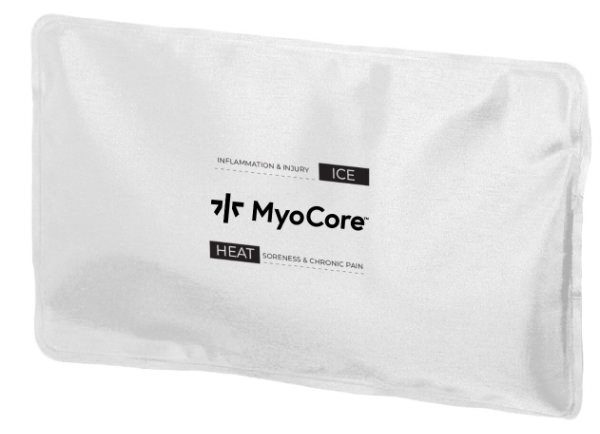
Tips For Joint Health
Stay In Motion – The more you move, the less stiff you’ll be. Change positions and take a 10-minute movement break every hour.
Treat Joint Injuries – Injuries can add to the breakdown of cartilage in your joints. If you get hurt, see your doctor right away for an evaluation.
Strengthen Your Muscles – With proper strength training, you will increase your joints’ stability while decreasing pain.
Drink More Water – Proper hydration can improve the production of synovial fluid, reduce inflammation and maintain the shock-absorbing properties of cartilage.
Omega-3, Vitamin D, & Calcium – Ensure your diet is rich in these crucial nutrients. Omega-3 lowers inflammation and keeps joints healthy. Vitamin D and Calcium are required for healthy bones.
For more tips, download our Free Beyond the Back – Chiropractic & Extremity Care Guide
We understand that your days look different and you may not be as active as you were pre-COVID. At MyoCore, our goal is to get you back to the activities you enjoy and reduce any potential pain or discomfort in the process. A great way to support and strengthen muscles between visits safely and effectively is with resistance bands. Below are a few exercises you can do at home to improve your mobility and flexibility. Whether you’re working from home at the dining room table, spending hours helping your kids with online homework or binging the latest show on Netflix, here are three easy, low impact resistance band exercises to increase your mobility and flexibility!
Glute Bridge
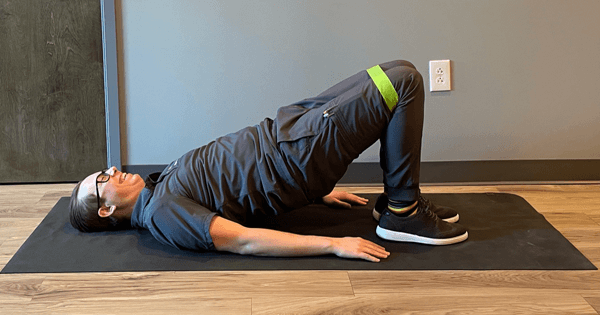
This glute bridge exercise is ideal if you are experiencing lower back or sciatica-type pain. One common cause of lower back issues is weakness in the glutes which can lead to many different compensations that commonly cause pain.
1. Starting Position
- Begin lying on the floor.
- Place the resistance band around your thighs, just above your knees.
- Bend your knees with your feet flat on the floor, and your arms extended to sides.
2. Movement
- Activate your core muscles.
- Slightly abduct your legs while simultaneously performing a hip bridge, attempting to attain shoulder, hip and knee alignment.
- Slowly lower back to the start position without bringing knees together.
3. Repeat
- As prescribed or as you feel appropriate.
Resisted Neck Retractions
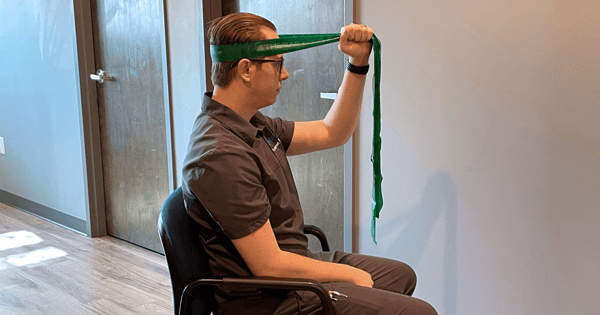
One exercise to reduce neck pain is neck retractions. Adding resistance bands to this exercise can be beneficial to decrease pain, improve posture, and activate your muscles.
1. Starting Position
- Begin in a seated or standing position, looking forward with your shoulders back with neutral posture.
- Place the resistance band around the back of your head.
- Hold the ends with each hand at shoulder level, straight in front of you.
2. Movement
- Activate your core muscles.
- Attempt to draw your head directly backward.
- Maintain level head position. Do not tilt your head up or down.
- Hold for two seconds and release to the starting position.
3. Repeat
- As prescribed or as you feel appropriate.
Brugger’s With Resistance

Brugger’s is an exercise that is great for resetting your posture, especially if you work long hours at a computer. Posture is affected by what we call “Upper Cross Syndrome,” characterized by a forward head posture, rounded shoulders, and a slumped mid-back. Adding a resistance band is perfect for improving your mobility and flexibility.
1. Starting Position
- Begin seated or standing with your back flat against a wall or chair.
- Position the resistance band in both hands.
- Your hands should be in front of you, palms facing one another, thumbs up, and elbows at 90 degrees.
2. Movement
- Begin by extending your wrists while turning your palms up.
- Pull your hands apart by rotating your shoulders externally while straightening your elbows.
- Slowly return your arms to the start position.
3. Repeat
- As prescribed or as you feel appropriate.
Are you interested in incorporating resistance band exercises into your routine care? Talk with your MyoCore chiropractor for more information on which resistance band exercises can best support your treatment plan and improve your overall health.
Feel free to consult with your doctor before starting new exercises.
3 Easy Resistance Band Stretches
Check out three easy low-impact resistance band exercises from Dr. Koerner to strengthen your mobility & flexibility and improve your posture.
Chiropractic can help more than just your neck and back! Download this infographic to learn all about how chiropractic care can help with extremity issues like carpal tunnel, sciatica, arthritis and much more.
Most of us understand the importance of going to the doctor after an auto accident, especially if you have any discomfort, pain, or injuries, but did you know that even seemingly minor auto accidents can have harmful effects on the body? 40% of all spinal injuries in a given year are the result of a car accident.1 After minor accidents, it can be common not to feel pain or have pain that starts a few days after the trauma. Your health is essential, and there are several reasons to have a chiropractic evaluation after an auto crash.
1. You May Be Hurt But Feel Fine
How you feel is not the best indication of a potential injury. After minor accidents, most people will not feel much pain, or their pain may start days or even weeks later. You could have injuries where you feel no pain at all. Seeing a chiropractor early on will help identify potential problem areas before you start experiencing pain.
Some injuries that don’t present themselves right away include:
- Whiplash – neck injury that occurs when the head is rapidly thrust backwards and then forwards.
- Soft Tissue Injuries – injury that involves the muscles, tendons or ligaments of various areas of the body.
2. Delay in Pain or Injury
Many injury symptoms can take time to surface and frequently do not manifest until hours or days after an accident. Endorphins and adrenaline, your body’s natural “pain killers,” can be present after a car accident and disable pain due to high levels of stress.
3. One Accident = Four Collisions
Every vehicle accident has four separate collisions happening to the car and driver.
The first collision is the car striking another car or object. Your vehicle may be pushed forward due to this force, causing the second collision, which is the seat hitting or going against your body. As your body moves forward, the third collision will be your head or body hitting the seat belt or airbag. Lastly, there is an internal collision when your organs collide with the inside of the body. All of these separate collisions may cause injury.
We find that even in an 8 mph collision, the g-force will equal 2 g’s on the vehicle and as much as 5 g’s on the occupant’s head. The average head weighs 10 pounds, which means in this scenario, up to 50 pounds of force is acting on the head and neck. Research shows that these low-speed collisions may be more harmful to the neck than a high-speed crash.
Common injuries may include
- Contusions
- Sprains/strains
- Whiplash
- Concussion
- Fracture
- Dislocation
Auto accidents, including a minor fender-bender, can have a significant impact on your health. Play it safe. Always wear your seatbelt, drive carefully, and please have a chiropractic evaluation following any motor vehicle accident.
Sources:
How Our Chiropractors Use Myofascial Release Therapy to Treat Common Conditions
Living with acute and chronic pain is not only difficult, but it can have a negative impact on your quality of life, emotional state, and stamina to function throughout the day. When a deep ache in your low back or a persistent headache goes from mildly annoying to 100% debilitating, relief quickly becomes both necessary and vital. The good news is that many of these types of common conditions affect the musculoskeletal system, which in turn means they can be resolved with advanced deep tissue treatments, such as Myofascial release (MFR) therapy.
Our chiropractors at MyoCore use MFR therapy to alleviate pain, improve mobility, and optimize your care. They work closely with medical doctors, physical therapists, and other healthcare professionals to provide personalized treatment plans that follow best-in-class protocols. Through an integrated care approach, they are able to better understand their patients’ needs, tailor the right combination of applicable techniques, and perform hands-on, deep tissue treatments that help.
The following information gives a comprehensive understanding of what and how Myofascial release (MFR) therapy can be used to treat common conditions. If you are interested in learning more, find a chiropractor near you that performs MFR.
What is Myofascial Release (MFR) Therapy?
Myofascial release (MFR) therapy is a deep tissue manual therapy technique that focuses on releasing muscular shortness and tightness that cause pain within the body. The technique targets skeletal muscle and connective tissues that are ‘bound’ by tight fascia in the form of adhesions (dense collections of scar tissue) and trigger points (hyperirritable spots that refer pain to other areas of the body). MyoCore specialists use deep, focused manual pressure and stretching to the area to release adhesions and trigger points. This in turn relaxes and restores function to the muscle and its associated joint so that the patient experiences relief and recovery. MFR treatments address the underlying causes of dysfunction and therefore have longer lasting results.
Trigger-point therapy is a form of MFR that applies direct pressure to tense, dense knots of tissue called trigger points. By applying pressure with a finger or other instrument the trigger point eventually “releases” tension and softens so that the area regains its natural function. There are a number of variations on this technique that a skilled practitioner will be able to apply. Some examples include Active Release Technique®, which retrains the muscles’ neurological response pattern so they can relax, and the Graston Technique®.
What Common Conditions Benefit from Chiropractic Treatments Using Myofascial Release (MFR) Therapy?
Since fascia is a connective tissue that runs head to toe in a web-like system, restrictions along its pathway can produce symptoms such as pain, headaches, disease, and dysfunction. The following common conditions can be addressed with safe and effective MFR treatments.
Neck Pain and Headaches
Neck pain is commonly due to postural misalignment, trauma, or inflammation in the soft tissues surrounding the head and neck. Tension within the muscles and tendons can cause localized or referring pain, as well as acute or chronic headaches. MFR can be used to mitigate the pain by reducing the dysfunction of muscle spasms, tightness, and trigger points.
Learn how chiropractic can treat headaches.

Shoulder Pain
Causes of shoulder pain can range from mild to severe as a result of general wear and tear or complete rotary dysfunction. MFR has the ability to address particular areas that are bound and restore pain-free range of motion to the entire shoulder joint.

Back and Lower Back Pain
Acute or chronic back pain is a common form of discomfort that can be caused by injury, poor posture, or other habitual physical movements that result in regular wear and tear. By applying MFR to specific areas along the spine and addressing surrounding musculature, back pain can be alleviated or minimized in a manageable way. The goal is restore full function and mobility, which is possible using a variety of MFR techniques.
Learn how chiropractic can treat back pain.
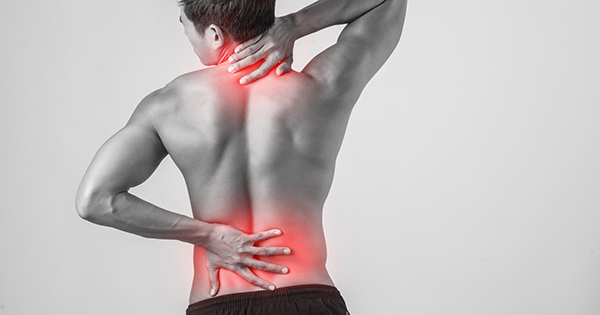
Arm Pain, Leg Pain, and Numb Fingers
Extremity pain typically refers to anything from your arms to fingers and hips to toes (i.e., arms, wrists, fingers, ankles, toes, knees, etc.). MFR applied directly to the affected musculature and to the surrounding areas can help reduce pain, restore function, and improve the associated joint’s range of motion. Specific tools and techniques enable MFR practitioners to work with everything from small to large muscles in an effort to aid in rehabilitation.
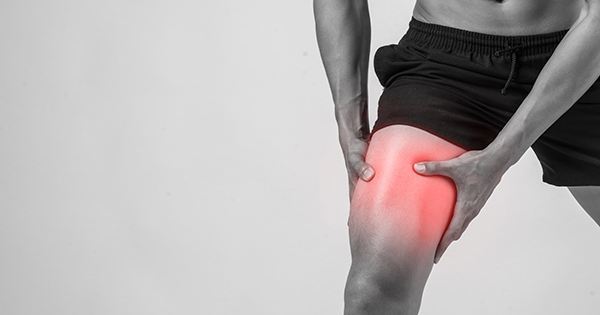
Fibromyalgia
Fibromyalgia is a chronic disease that affects the bones and muscles. Myofascial release (MFR) therapy is key to any fibromyalgia treatment because it increases blood and lymphatic circulation, decreases sensitivity, and reduces chronic inflammation.
Learn how chiropractic can treat fibromyalgia.
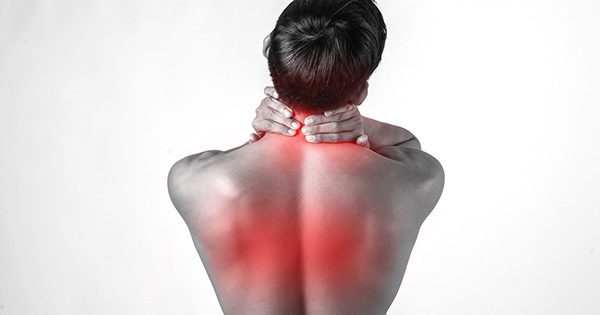
Plantar Fasciitis
Plantar Fasciitis involves inflammation of a thick band of tissue that runs across the bottom of your foot and connects your heel bone to your toes. It can cause limitations and pain in a variety of activities including running, walking, jogging, and hiking. Using MFR along the sole of the foot and into the calf muscles helps reduce pain, increase fascial mobility, and improve joint function.
Learn how chiropractic can treat plantar fasciitis
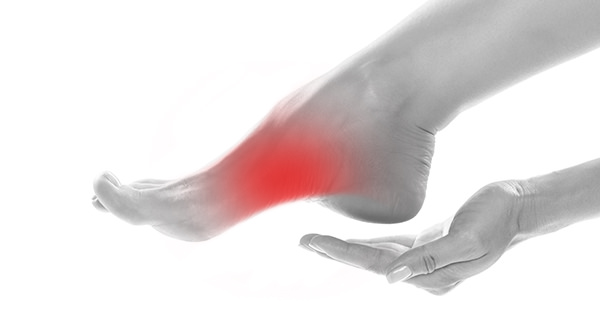
Treat Common Conditions with MFR
With a commitment to educate, empower, and support our patients, MyoCore works with a team of professionals to offer a variety of MyoFascial release (MFR) therapies that are designed to aid in recovery. We are dedicated to improving the quality of life of every patient through drug-free, noninvasive treatments that relieve pain, improve joint motion, optimize muscle function, and increase flexibility. If you are experiencing any of the above common conditions and are ready to find a chiropractor near you that performs MFR please contact us. We are here to help.
There are many causes for chest pain, both cardiac and non-cardiac. Some can be difficult to identify. Here’s what you should know about chest pain.
What causes chest pain that’s not heart-related?
Chest pain can be caused by numerous issues that are not heart-related. Many body parts located in the chest can cause pain and discomfort. Muscles, bones, connective tissues, nerves, skin, the lungs, the aorta, the esophagus, and the stomach can all cause chest pain.
Chest pain can be associated with several cardiovascular system issues, including the heart and blood vessels, the pulmonary system, the digestive system, and the musculoskeletal system.
Chest pain can also radiate to the neck, face, shoulders, back, and arms as a cause for musculoskeletal or referred pain. Musculoskeletal pain can often occur from inflammation or injury to the muscles or bones of the chest wall. This can be due to trauma, arthritis, or other conditions such as fibromyalgia.
What is the most common?
By far, the most common cause of chest pain is musculoskeletal.
Health care providers can determine the source of pain from patient exams and diagnostic tests, and studies show that almost 50% of chest pain is related to musculoskeletal origin 1. Chiropractic care is a precise fit for patients whose pain source is musculoskeletal and not cardiovascular.
At MyoCore, we specialize in chronic musculoskeletal pain through drug-free, non-invasive treatments that relieve pain. Our therapies along with other assessments can help manage soft tissue and muscle pain to keep your body functioning properly.
Patients who experience musculoskeletal related chest pain are often underdiagnosed leading to increases in depression and anxiety with associated decreases in quality of life, which can become chronic and disabling if not diagnosed and treated 2.
Common Musculoskeletal Causes for Chest Pain
Cervical radiculopathy occurs when there is a disk herniation or a nerve root irritation in the neck 3
Myofascial trigger points in the pectoralis muscles and neck muscles 4,5
Costochondritis is a painful condition from inflammation affecting the junction of the ribs and cartilage at the sternum 6
Segmental dysfunction and neurologic input in the lower cervical spine and upper thoracic spine 7
Heart Health
Our chiropractic doctors recognize the importance of a persons’ whole-body health. Since chest pain is one of those symptoms associated with emergent, life-threatening conditions, you should always seek medical attention for chest pain.
Our hospital-based integrated care model gives our doctors access to the top cardiovascular specialists in our communities. This allows our practices to co-manage and make referrals for care to serve our patients’ heart health’s best interests. We determine the cause of pain and offer movement therapies for improved health and reduced pain. At the same time, consistently see our patients have an increase in their quality of life.
We are your dedicated partners in conservative pain care and your healthy heart journey.
References
- Ayloo A, Cvengros T, Marella S. Evaluation and treatment of musculoskeletal chest pain. Primary Care: Clinics in Office Practice. 2013;40(4):863-887.
- Stochkendahl MJ, Christensen HW. Chest pain in focal musculoskeletal disorders. Med Clin North Am. 2010 Mar;94(2):259-73. doi: 10.1016/j.mcna.2010.01.007. PMID: 20380955.
- Mork AA, Haufe SM, Yancey WB. Sometimes (what seems to be) a heart attack is (really) a pain in the neck. J Am Board Fam Pract. 2004 Jan-Feb;17(1):74-7. doi: 10.3122/jabfm.17.1.74. PMID: 15014058.) (Mitchell LC, Schafermeyer RW. Herniated cervical disk presenting as ischemic chest pain. Am J Emerg Med. 1991 Sep;9(5):457-60. doi: 10.1016/0735-6757(91)90215-6. PMID: 1863303.
- Bagcier F, Volkan Yurdakul O, Ozduran E. Three simple rules in pectoral muscle’s trigger point treatment, which may be a cause of chest pain: position, palpation, and perpendicular needling. J Am Board Fam Med. 2020;33(6):1031-1031.
- Choi YJ, Choi SU, Shin HW, Lee HW, Lim HJ, Chang SH. Chest pain caused by the trigger points in the scalenus muscle – a case report -. Korean J Anesthesiol. 2007;53(5):680.
- Proulx AM, Zryd TW. Costochondritis: diagnosis and treatment. Am Fam Physician. 2009 Sep 15;80(6):617-20. PMID: 19817327.
- Foreman RD. Mechanisms of cardiac pain. Annu Rev Physiol. 1999;61(1):143-167.
Is Pain Interrupting Your New Year’s Resolution?
The number one most popular New Year’s resolutions made amongst the US population, is to improve health and fitness through exercise. One of the most common reasons this resolution can fail is due to the onset of back pain. Many patients come into our office this time of year with pain that either resulted from injury while exercising, or pain that came on for seemingly no reason and is keeping them from achieving their exercises goals.
One of the most common (and most painful!) conditions we see as a result of beginning an exercise regimen or increasing one’s current exercise program is an increase in or onset of back pain – more specifically sciatica. Sciatica is a broad term that many patients use for any type of pain that radiates into their leg or legs. However, not all sciatica is created equal. Causes of pain radiating into the leg can range from a simple muscle spasm to a herniated disc with compressive neuropathy. Many types of lower back and leg pain can be managed with simple exercises but sometimes it is necessary to see a professional.
Top 3 Stretches For Sciatica Relief
There are several useful exercises you can perform on your own to help resolve the causes of radiating lower back pain and pain into the leg. Here’s our top three!
McKenzie Lumbar Extension

- Begin lying face down on floor or firm surface with elbows bent and hands under shoulders.
- Slowly extend your arms as you press your body upward arching your back and gently squeezing your lower back muscles. Once arms are fully extended, pause momentarily, then slowly lower yourself down to the start position.
- Perform this exercise 10x every hour. STOP this exercise if it seems to worsen your leg pain.
Piriformis Figure 4 Stretch

- Begin lying on your back. Cross one leg over the other, placing ankle on opposite thigh above the knee.
- Grasp uncrossed leg under-thigh and gently pull towards the chest. A stretch in the hip of the crossed leg should be felt. Hold for 20-30 seconds and repeat for prescribed repetitions.
- Perform this stretch 2-3 times per day on the affected side
Psoas Stretch

- Start in a lunge with the back knee down.
- Keeping your back straight, shift your hips forward until you feel a stretch.
- Hold the stretch for 20 to 30 seconds.
- Switch legs and repeat until you feel adequately stretched.
When To See A Professional
If pain persists despite trying these exercises or you develop numbness, tingling, or weakness, then it is time to see a professional. There could be a more significant issue causing the pain, or you just may need additional muscle work, stretches, and exercises outside of what you can do on your own.
If pain is keeping you from reaching your 2021 goals, schedule an appointment at one of our offices today!
